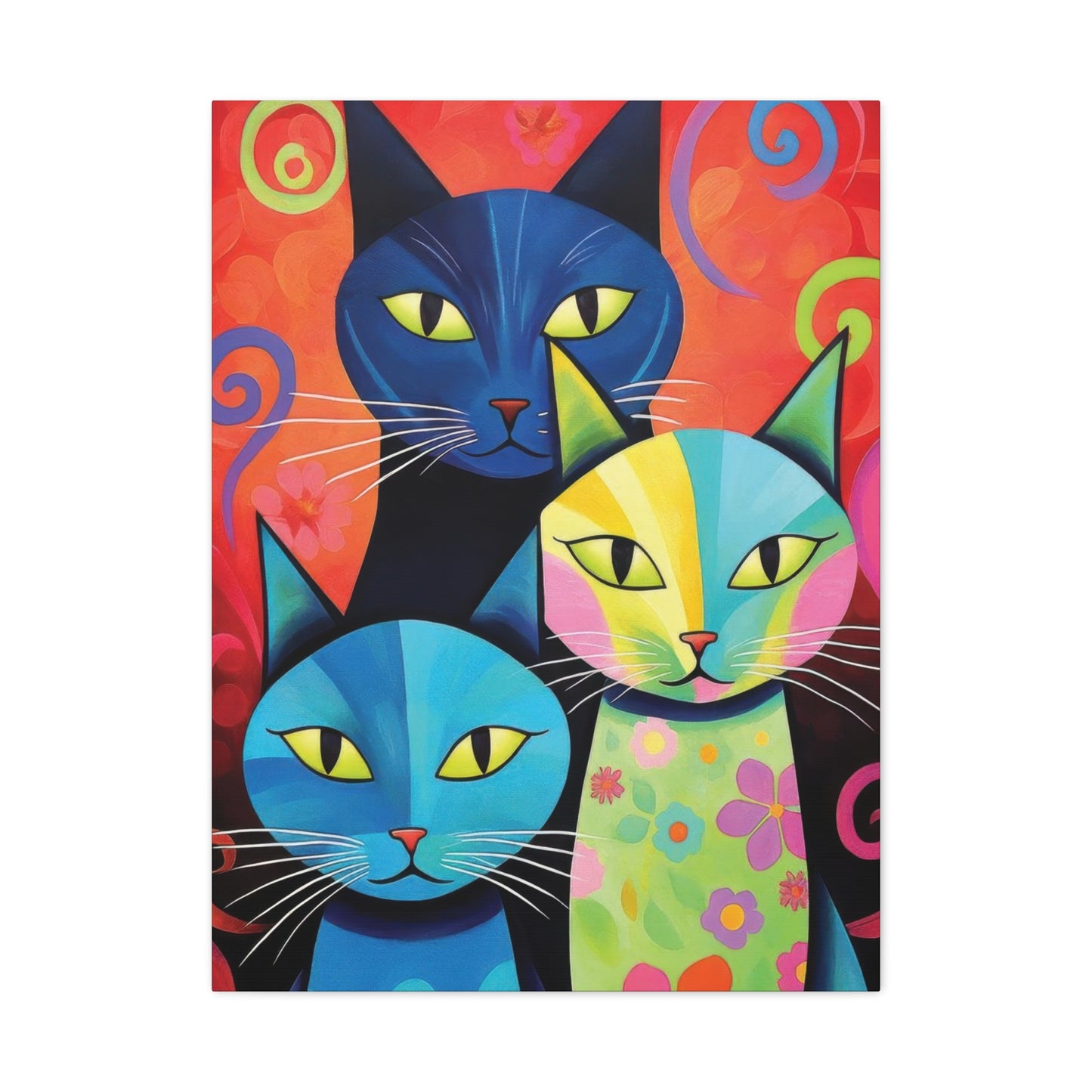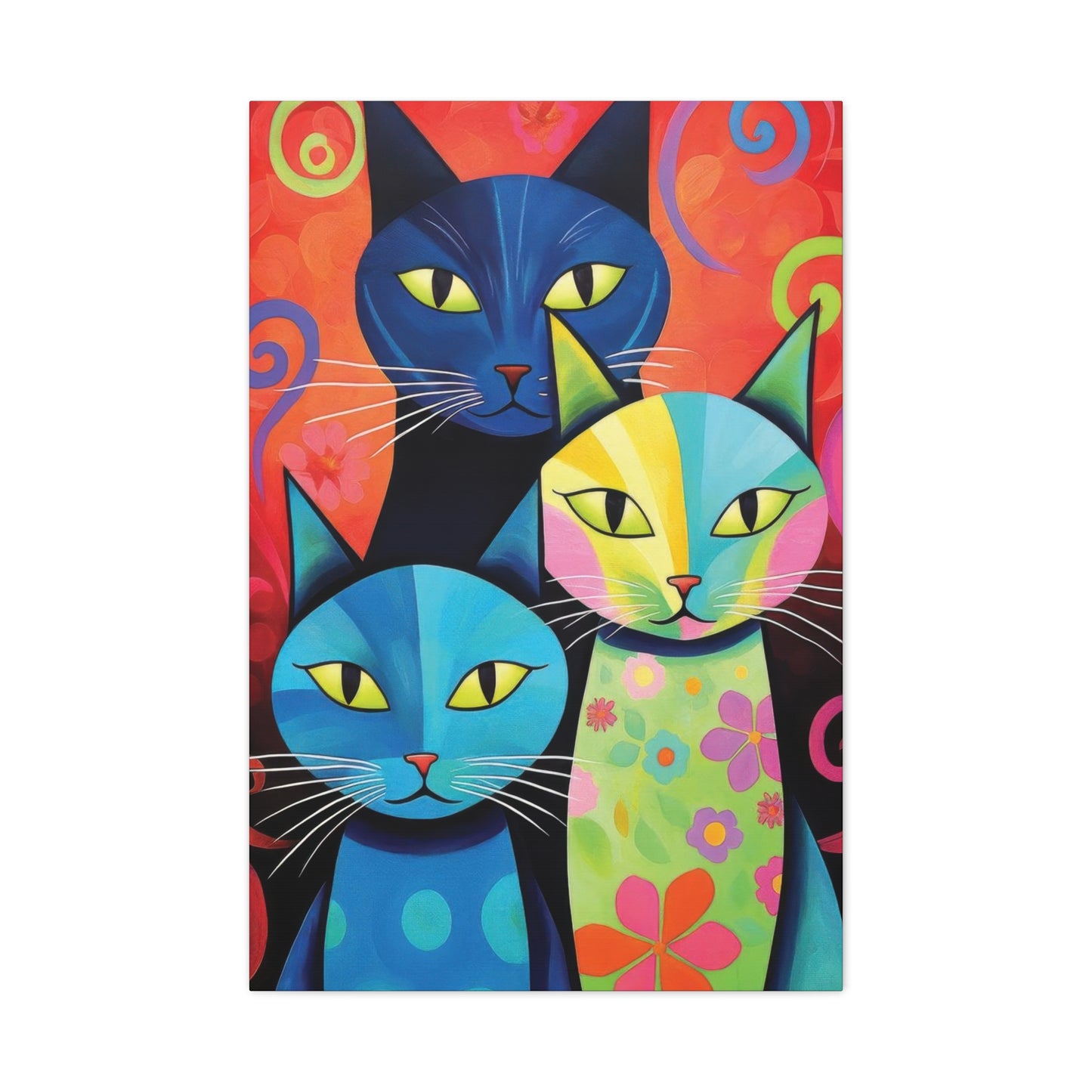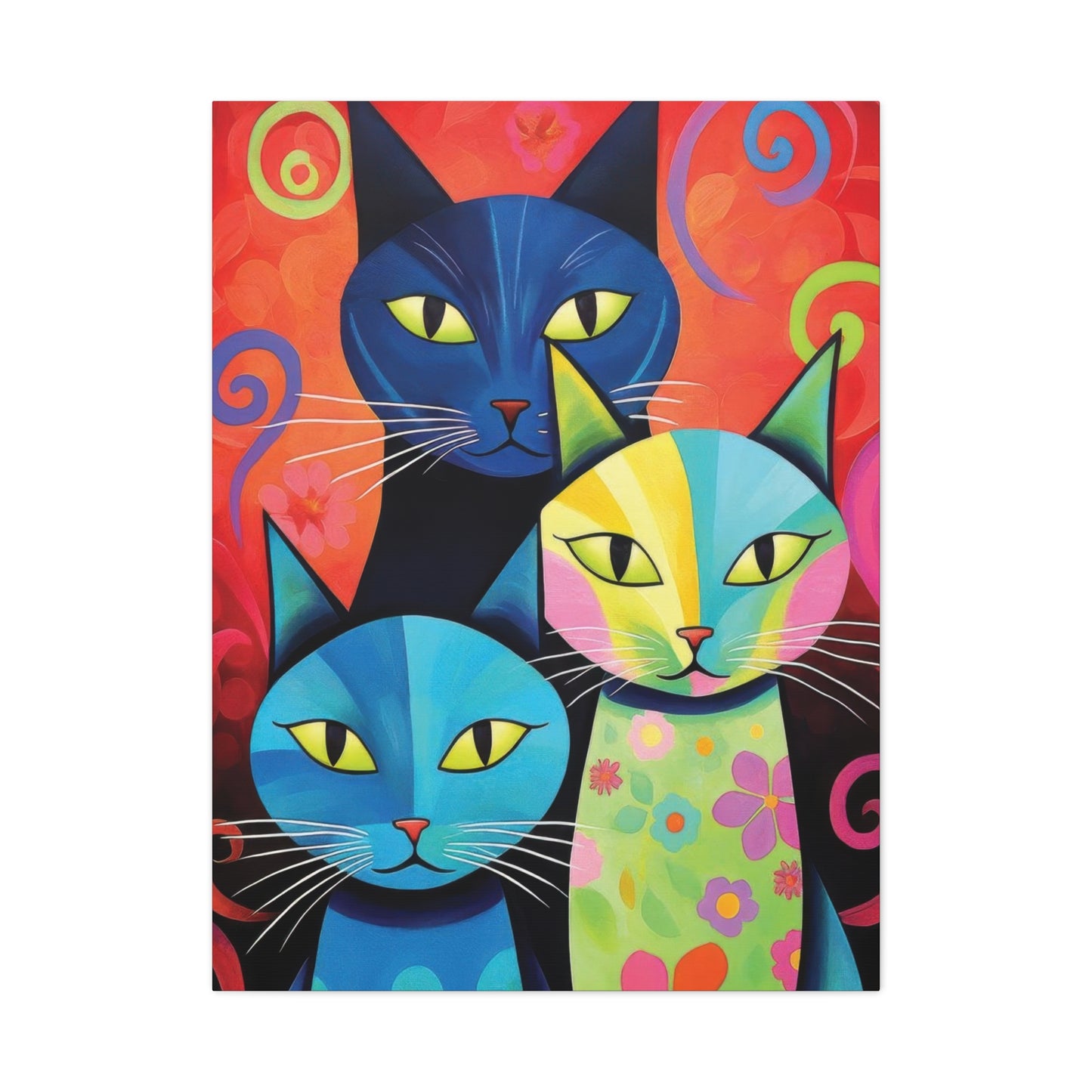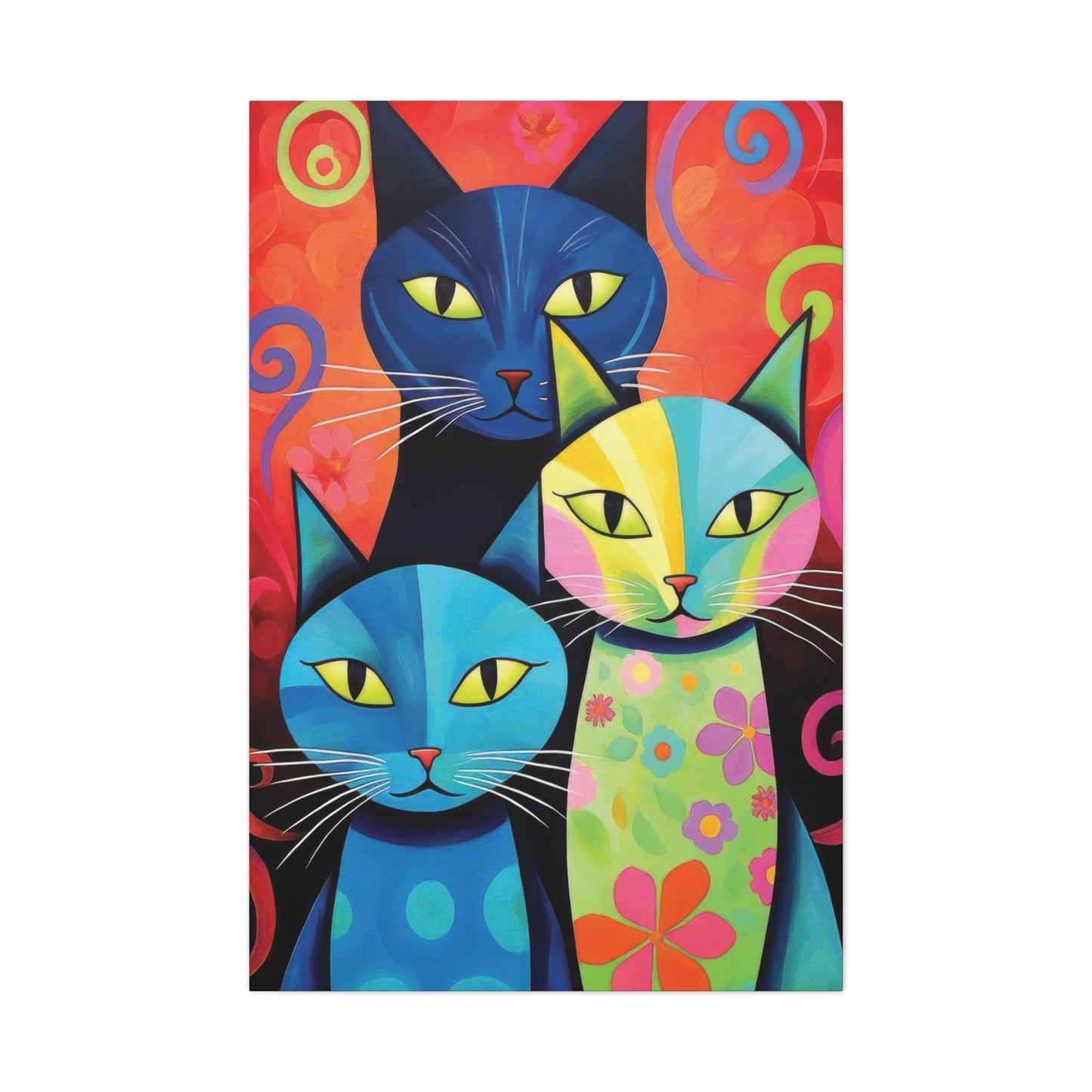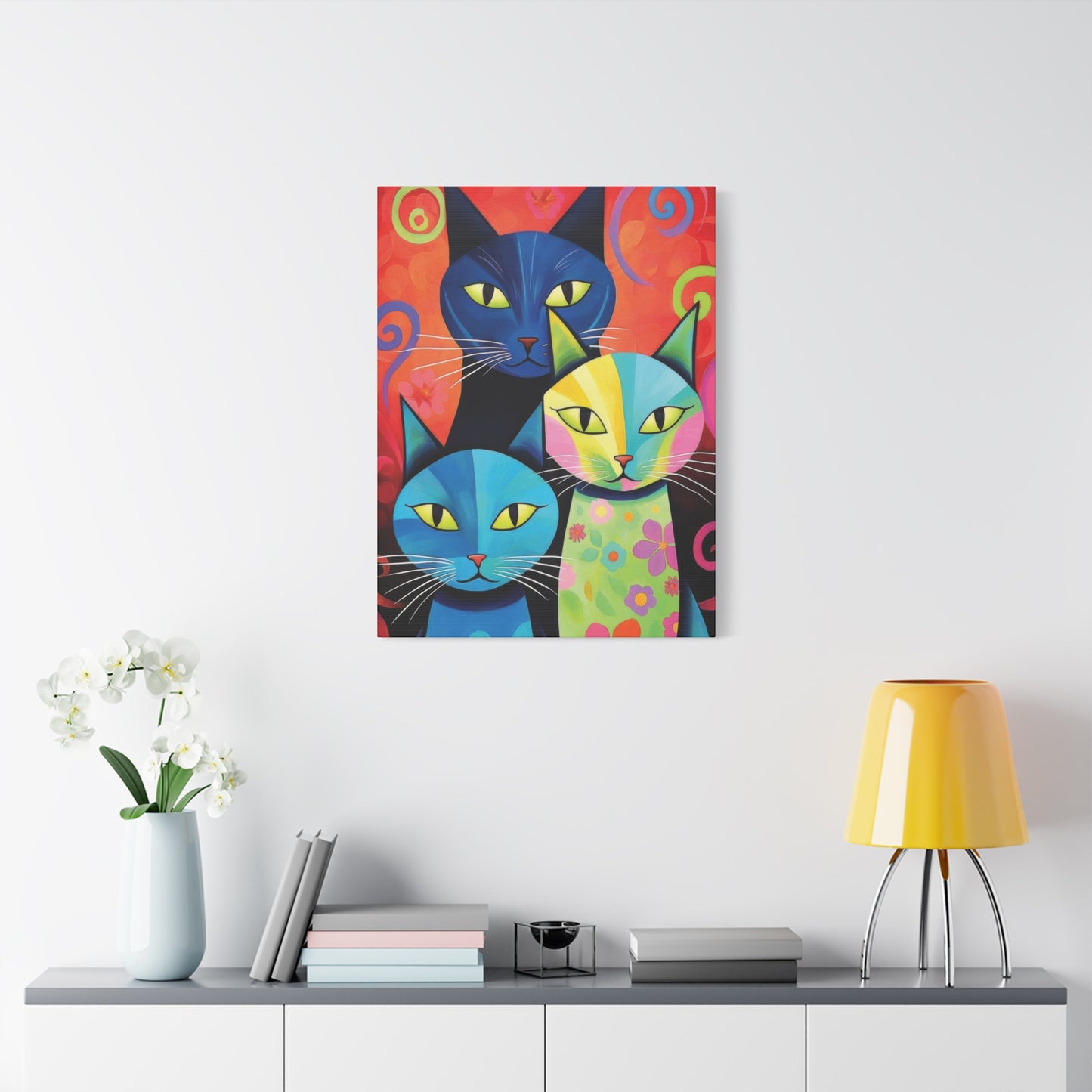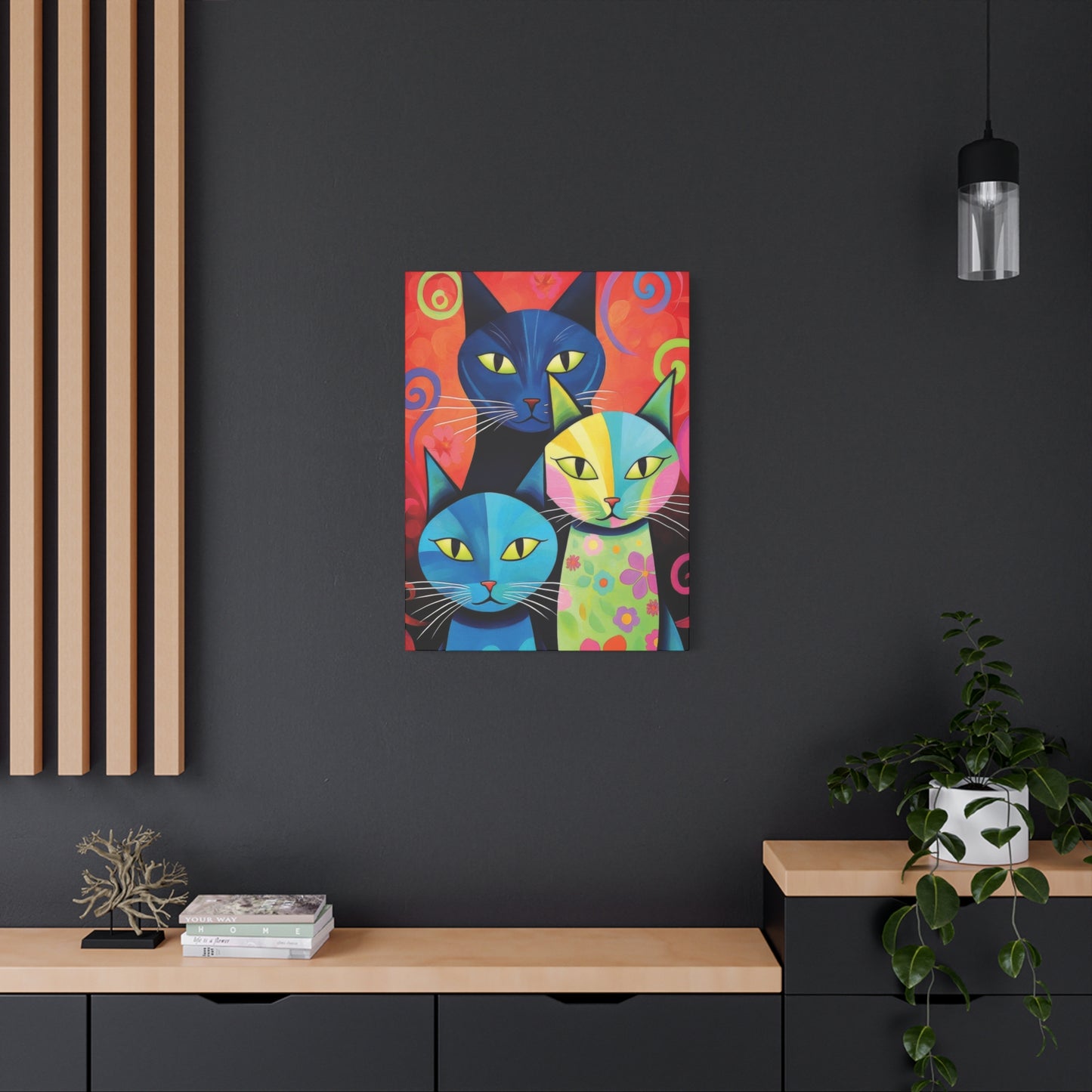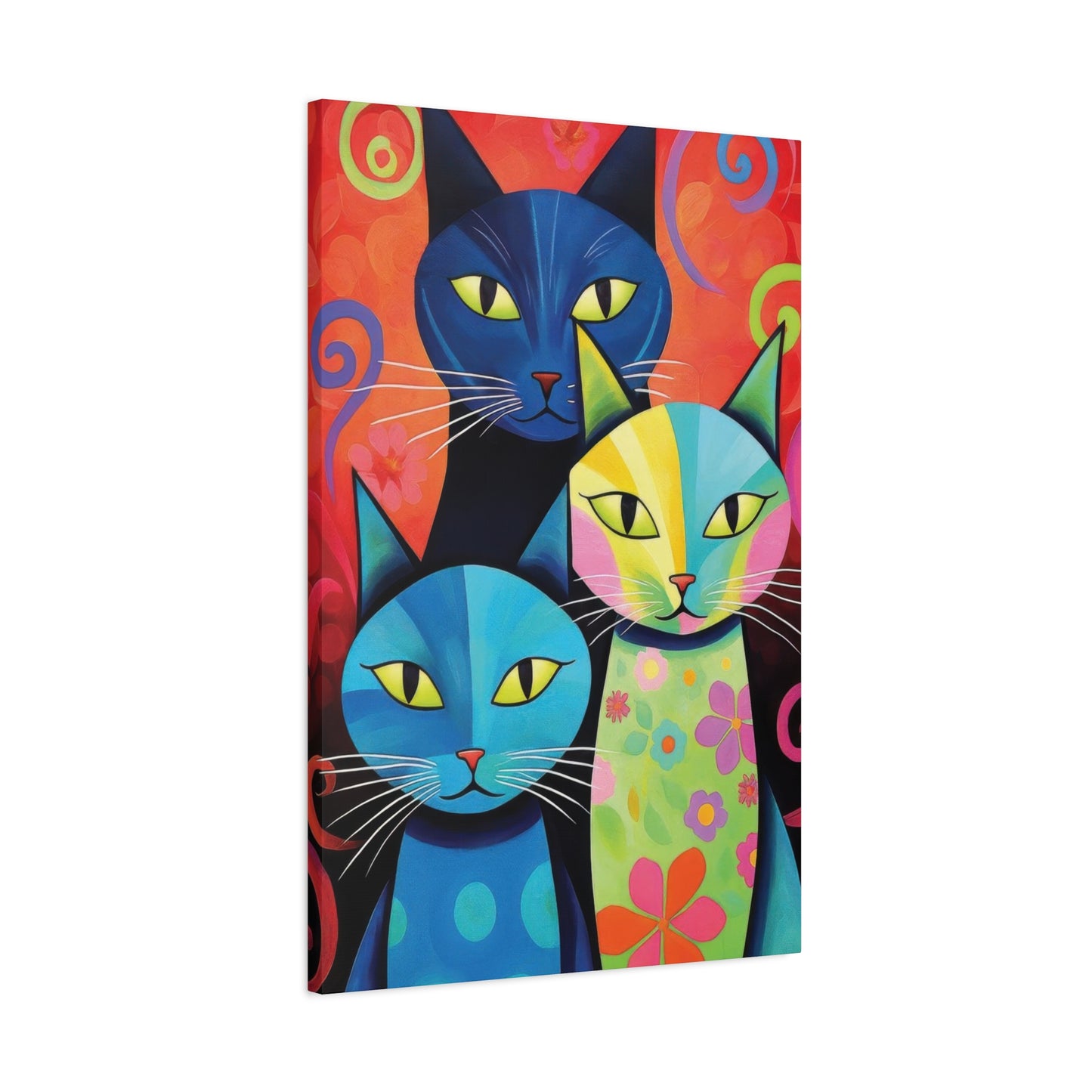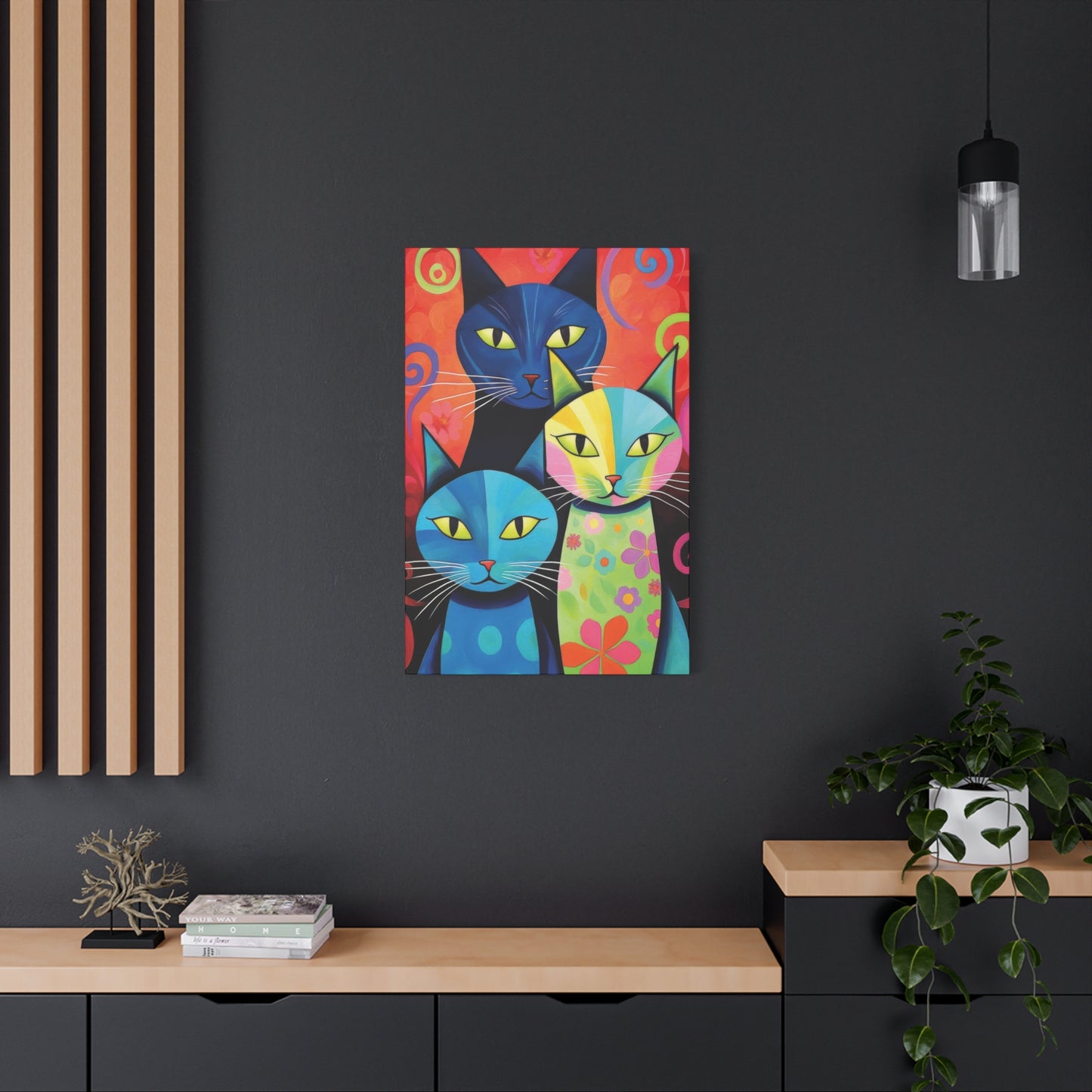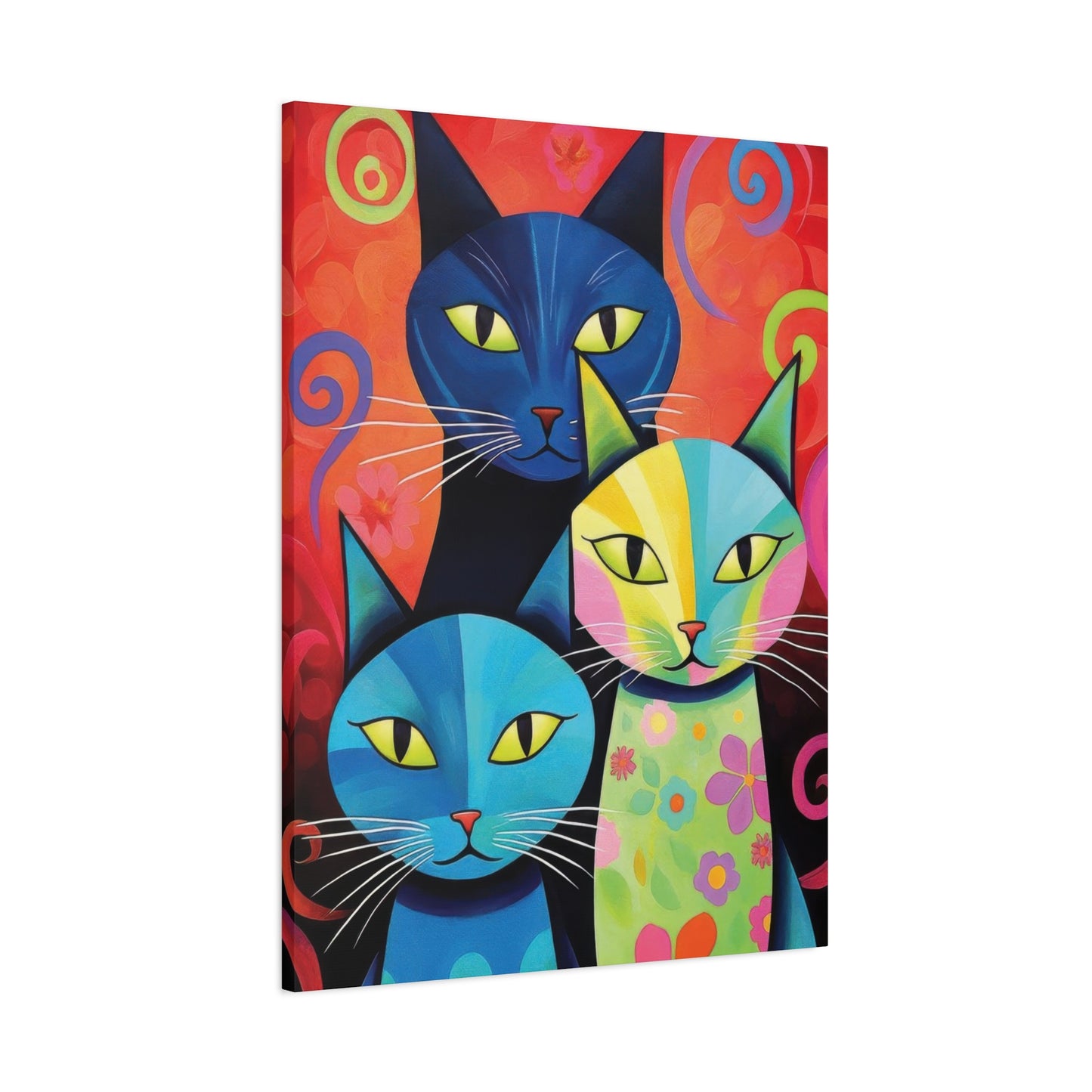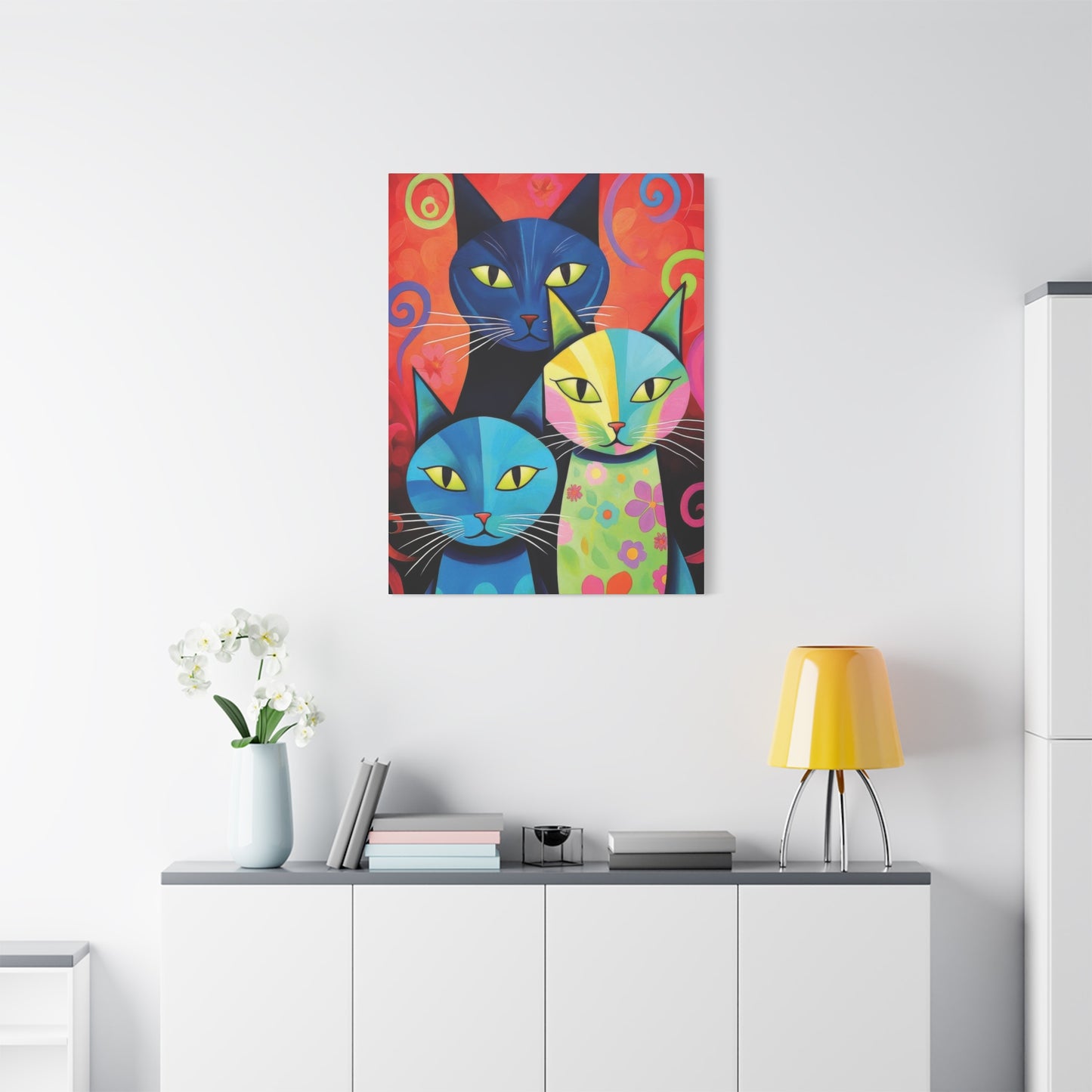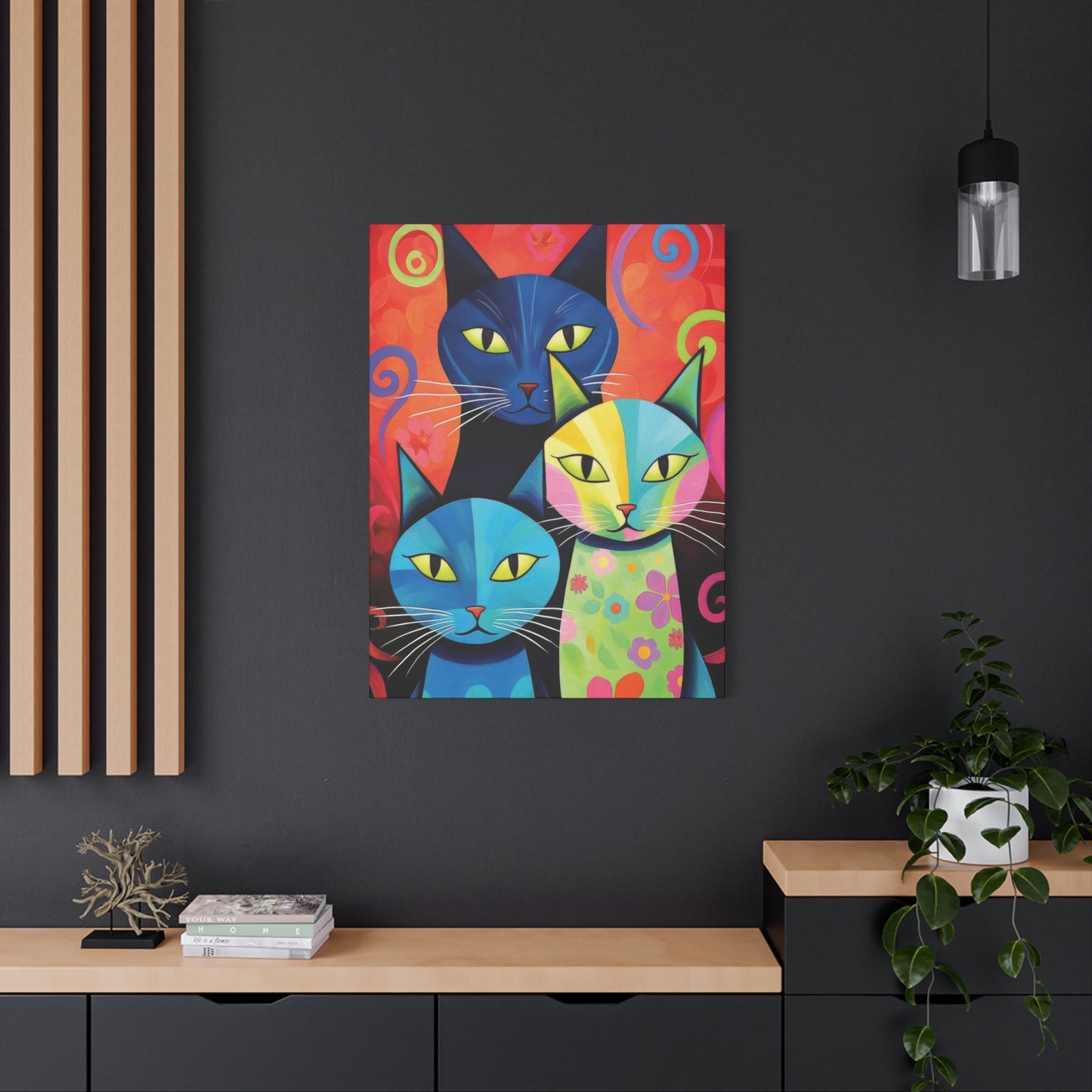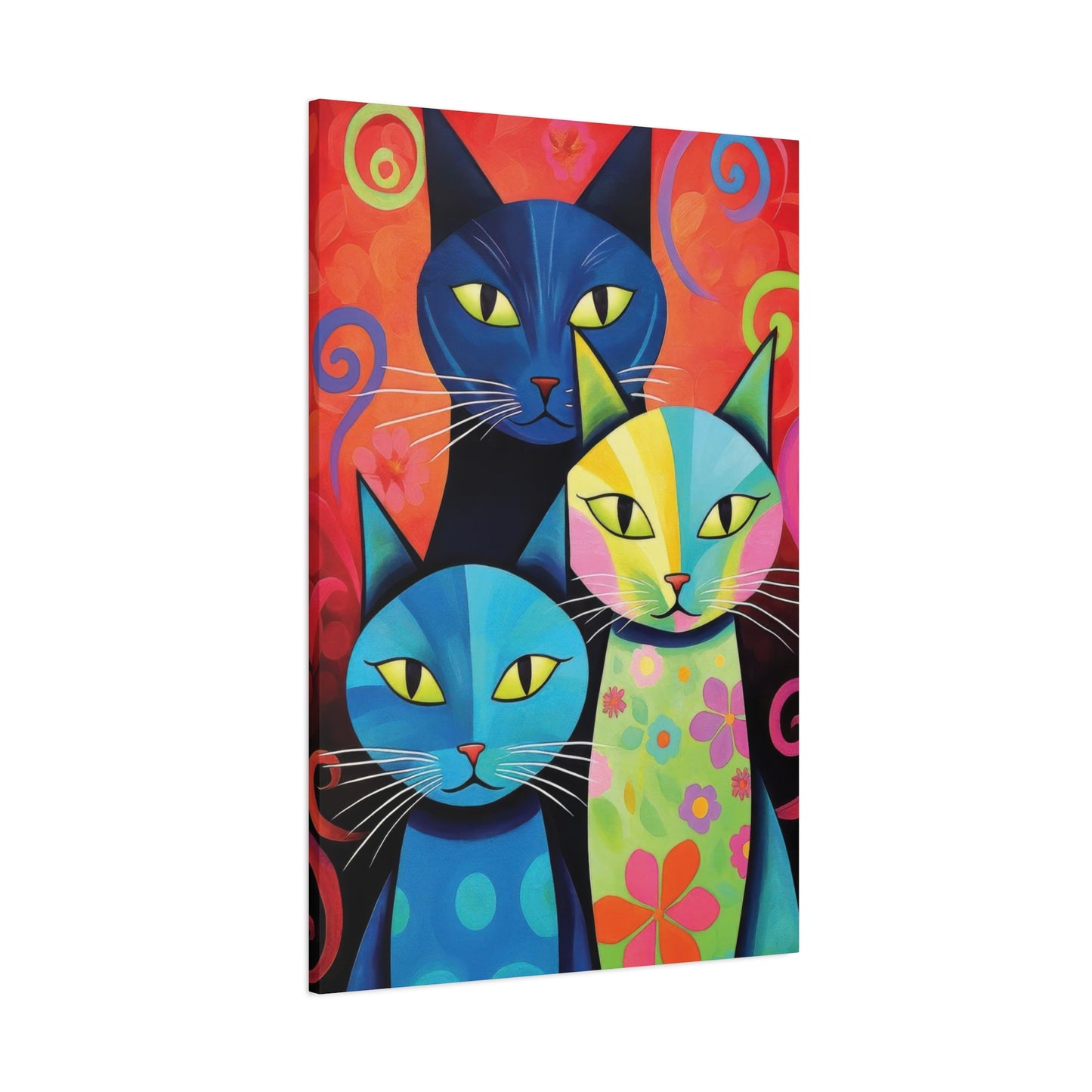A Celebration of Love and Line: Cat Family Abstract Fresh Canvas Wall Art
The world of home decoration has witnessed a remarkable evolution in recent years, with animal-inspired artwork claiming a prominent position in contemporary interior design. Among these creative expressions, feline-themed artistic pieces have emerged as particularly captivating choices for homeowners and design enthusiasts alike. The magnetic appeal of cat imagery combined with modern artistic techniques creates stunning visual statements that transform ordinary living spaces into extraordinary environments filled with personality and charm.
Feline subjects have maintained their position as beloved motifs throughout art history, from ancient Egyptian hieroglyphics to modern digital creations. Today's designers and artists continue this tradition while infusing fresh perspectives and innovative approaches that resonate with current aesthetic sensibilities. The fusion of traditional appreciation for cats with contemporary design principles results in artwork that speaks to both our timeless fascination with these creatures and our desire for modern, stylish living environments.
The rising popularity of animal-themed decorative pieces reflects a broader cultural shift toward personalization in home design. People increasingly seek artwork that reflects their passions, interests, and connections to the natural world. Cat-themed pieces satisfy this desire while offering versatility in style, color, and composition. Whether displayed in minimalist apartments, eclectic studios, or traditional family homes, these artistic creations adapt beautifully to various design contexts while maintaining their distinctive character.
The Rising Popularity of Feline Imagery in Modern Home Decoration
Contemporary interior design has embraced animal motifs with unprecedented enthusiasm, and feline representations stand at the forefront of this movement. This surge in popularity stems from multiple factors that converge to make cat-themed artwork particularly appealing to modern consumers. Understanding these underlying reasons helps explain why countless homeowners choose feline imagery to enhance their living spaces.
The psychological connection between humans and cats plays a fundamental role in the appeal of feline artwork. Cats embody qualities that resonate deeply with contemporary values: independence, grace, mystery, and sophistication. These characteristics translate beautifully into visual representations that capture not just the physical appearance of cats but also their essence and spirit. Artwork featuring feline subjects often evokes emotional responses ranging from comfort and warmth to fascination and admiration.
Social media platforms have significantly amplified the visibility of cat-themed home decoration. Platforms showcase countless examples of beautifully decorated spaces featuring feline artwork, inspiring others to incorporate similar pieces into their own homes. This digital exposure creates a cyclical effect where increased visibility leads to greater demand, which in turn encourages artists and manufacturers to create more diverse and innovative products.
The versatility of feline imagery contributes substantially to its widespread appeal. Artists can interpret cat subjects through countless stylistic lenses, from hyper-realistic portraits to completely abstract representations. This range ensures that cat-themed artwork exists for virtually every aesthetic preference and design philosophy. Minimalists find satisfaction in simple line drawings, while maximalists delight in richly detailed, multi-layered compositions featuring elaborate feline figures.
Cultural factors also influence the popularity of feline decorative pieces. In many societies, cats carry symbolic significance representing luck, protection, wisdom, or spiritual connection. These cultural associations add layers of meaning to artwork featuring cat subjects, making them more than mere decorative objects but rather meaningful additions that reflect personal beliefs or cultural heritage.
The emotional comfort provided by feline imagery cannot be overstated. For cat owners, artwork featuring these animals serves as a constant reminder of beloved pets and the joy they bring. Even for those without cats, feline imagery often evokes feelings of tranquility, playfulness, and domestic contentment. These positive associations make cat-themed pieces particularly suitable for spaces designed for relaxation and rejuvenation.
Market trends reflect this growing enthusiasm for feline-themed decorative items. Sales data from home furnishing retailers consistently show strong performance for animal-themed artwork, with cat subjects frequently ranking among the top sellers. This commercial success validates the aesthetic and emotional appeal of these pieces while encouraging continued innovation in design and production methods.
Characteristics That Define Contemporary Feline Artwork
Modern feline artwork distinguishes itself through several defining characteristics that separate it from traditional animal portraits. These features reflect current artistic movements, technological capabilities, and evolving aesthetic preferences that shape contemporary visual culture. Understanding these characteristics helps consumers make informed decisions when selecting pieces for their spaces.
Abstract interpretation represents one of the most prominent features of contemporary feline artwork. Rather than focusing solely on realistic depiction, modern artists often reduce feline forms to essential elements, emphasizing shape, color, and composition over photographic accuracy. This approach creates artwork that captures the essence of cats while allowing for creative expression and stylistic experimentation. Geometric patterns, simplified forms, and bold color choices characterize this abstract approach, resulting in pieces that feel both familiar and refreshingly innovative.
Color palettes in contemporary feline artwork tend toward either subdued, sophisticated tones or vibrant, energetic combinations. The former approach utilizes neutrals, pastels, and muted shades to create serene, calming pieces that integrate seamlessly into modern interior spaces. The latter employs bold, saturated colors that create focal points and inject energy into rooms. Both approaches demonstrate the versatility of feline subjects as vehicles for color exploration and emotional expression through chromatic choices.
Minimalism profoundly influences contemporary feline artwork, with many pieces embracing the principle that less is more. Simple line drawings, limited color palettes, and generous negative space characterize this aesthetic approach. These minimalist interpretations appeal to contemporary sensibilities that value clarity, simplicity, and refined elegance. The resulting artwork feels modern and sophisticated while maintaining the recognizable charm of feline subjects.
Texture and layering add dimensional interest to contemporary feline pieces. Artists employ various techniques to create visual and sometimes actual texture, from paint application methods to mixed media approaches combining different materials. These textural elements add depth and complexity, encouraging closer examination and creating more engaging viewing experiences. Layering techniques particularly allow artists to build richness and dimension within compositions.
Stylization offers another defining characteristic of modern feline artwork. Artists reimagine cat features in exaggerated or modified ways, creating interpretations that range from subtly stylized to dramatically transformed. Elongated limbs, oversized eyes, simplified facial features, or exaggerated proportions become tools for artistic expression. This stylization moves artwork beyond mere representation toward creative interpretation that reflects individual artistic vision.
Contemporary feline artwork often incorporates elements from various design movements and cultural influences. Mid-century modern aesthetics, Scandinavian design principles, Japanese artistic traditions, and street art influences all find expression in current feline-themed pieces. This eclecticism reflects the globalized, interconnected nature of contemporary art and design, where boundaries between styles and traditions become increasingly fluid.
Digital creation techniques have revolutionized contemporary feline artwork. Many modern pieces originate as digital creations, allowing for precision, experimentation, and easy modification that traditional media cannot match. Digital tools enable artists to explore countless variations, perfect compositions, and achieve effects difficult or impossible through conventional methods. The resulting artwork often possesses a distinctive contemporary quality that reflects its digital origins.
Color Theory and Palette Selection for Feline Artistic Pieces
Color choices dramatically impact the effectiveness and appeal of feline artwork within interior spaces. Understanding color theory and how different palettes function within home environments helps both artists and consumers make decisions that maximize visual impact while ensuring harmonious integration with existing decor. The relationship between color and emotion, space perception, and aesthetic coherence makes palette selection a critical consideration.
Neutral color schemes offer timeless elegance and versatility in feline artwork. Combinations of black, white, gray, beige, and cream create sophisticated pieces that complement virtually any interior style. These neutral palettes allow feline subjects to shine through form and composition rather than relying on chromatic impact. Neutral-toned artwork integrates seamlessly into minimalist, modern, industrial, and transitional design schemes while providing subtle visual interest without overwhelming spaces.
Monochromatic color schemes explore variations within a single hue, creating cohesive, harmonious pieces with built-in color coordination. Blues ranging from pale sky tones to deep navy, greens spanning mint to forest shades, or warm tones progressing from cream to chocolate all provide frameworks for monochromatic feline artwork. This approach offers sophistication and visual unity while allowing for tonal variation that adds interest and dimension to compositions.
Complementary color combinations create dynamic visual tension and energy in feline artwork. Pairing colors opposite on the color wheel—such as blue and orange, purple and yellow, or red and green—generates vibrant, eye-catching pieces that command attention. These high-contrast combinations work particularly well in contemporary and eclectic spaces where bold statements enhance rather than conflict with overall design schemes. The energetic quality of complementary palettes makes them ideal for spaces intended to inspire creativity and vitality.
Analogous color schemes utilize colors adjacent on the color wheel, creating harmonious, naturally coordinated palettes. Combinations like blue-green-teal, yellow-orange-red, or purple-pink-magenta provide rich color experiences while maintaining visual cohesion. Feline artwork employing analogous palettes feels balanced and pleasing, working well in spaces where color coordination is important but some chromatic variety is desired. These schemes offer middle ground between monochromatic restraint and complementary boldness.
Pastel palettes bring softness and serenity to feline artwork. Pale pinks, soft blues, gentle lavenders, muted yellows, and light greens create soothing, approachable pieces perfect for bedrooms, nurseries, or any space designed for relaxation. The delicate quality of pastel-toned feline artwork appeals to those seeking gentle visual experiences rather than dramatic statements. These colors work particularly well in Scandinavian-inspired, shabby chic, or coastal design contexts.
Artistic Styles and Techniques in Modern Feline Portraiture
The diversity of artistic approaches applied to feline subjects ensures that cat-themed artwork exists for virtually every aesthetic preference. Contemporary artists employ numerous styles and techniques, each offering distinct visual qualities and emotional resonances. Familiarity with these various approaches helps consumers identify pieces that align with their personal tastes and interior design goals.
Abstract expressionism transforms feline subjects into explorations of color, form, and emotion. Rather than depicting cats literally, abstract expressionist pieces suggest feline presence through gestural marks, color fields, and compositional elements that evoke rather than represent. Splashes of paint, bold brushstrokes, and dynamic compositions create energetic pieces where viewers recognize feline essence without detailed rendering. This approach appeals to those valuing artistic expression and emotional impact over literal representation.
Geometric abstraction reduces feline forms to basic shapes and angular compositions. Triangles, circles, rectangles, and polygons combine to suggest cat silhouettes, faces, or poses through simplified geometry. This approach creates intellectually satisfying pieces where viewers delight in recognizing subjects through minimal visual information. Geometric feline artwork aligns perfectly with modern and contemporary interior styles, complementing clean lines and structured design elements common in these spaces.
Line art employs continuous or broken lines to define feline subjects with elegant simplicity. Single-line drawings that never lift from the surface create particularly striking effects, suggesting cat forms through minimal yet expertly placed marks. Multiple-line approaches build complexity while maintaining the essential clarity and directness that characterize line-based artwork. The sophistication and restraint of line art appeal to minimalist sensibilities and complement understated interior design schemes.
Pop art techniques apply bold colors, graphic elements, and cultural commentary to feline subjects. Inspired by commercial art and mass media, pop art-style cat pieces often feature bright, flat colors, strong outlines, and repeated or serial compositions. The playful, accessible quality of pop art makes it particularly appealing for casual spaces, creative environments, or anywhere a sense of fun and contemporary cultural awareness is desired.
Watercolor techniques create soft, flowing feline artwork with characteristic transparency and color blending. The fluid nature of watercolor allows for dreamy, atmospheric pieces where colors merge and interact organically. Feline subjects rendered in watercolor often possess a gentle, approachable quality that works beautifully in residential spaces, particularly bedrooms, reading nooks, or anywhere tranquility is valued. The inherent unpredictability of watercolor adds organic variation that enhances rather than detracts from finished pieces.
Compositional Principles for Effective Feline Artwork
Strong composition forms the foundation of visually compelling artwork regardless of subject matter. When creating or selecting feline-themed pieces, understanding compositional principles helps ensure artwork achieves its aesthetic and emotional goals. These timeless principles guide how elements arrange within a picture plane to create balance, interest, and visual satisfaction.
The rule of thirds divides compositions into nine equal sections using two horizontal and two vertical lines. Placing key elements along these lines or at their intersections creates naturally balanced, pleasing compositions. In feline artwork, positioning the cat's eyes, face, or body along these divisions typically produces more dynamic results than centering subjects. This principle helps avoid static, overly symmetrical compositions while creating natural focal points that guide viewer attention.
Balance ensures visual weight distributes appropriately across compositions. Symmetrical balance positions elements equally on both sides of a central axis, creating formal, stable compositions. Asymmetrical balance achieves equilibrium through careful arrangement of elements with different visual weights, producing more dynamic, interesting results. Feline artwork might balance a large cat figure on one side with smaller elements or negative space on the other, creating tension and interest while maintaining overall compositional harmony.
Focal points direct viewer attention to specific areas within compositions. In feline artwork, the subject's eyes typically serve as natural focal points, drawing viewers into the piece and creating connection between viewer and subject. Artists reinforce focal points through contrast, detail, color saturation, or compositional lines that lead toward important areas. Multiple focal points can exist within single compositions, though establishing clear hierarchies prevents confusion and ensures coherent visual experiences.
Negative space—the empty or background areas surrounding subjects—plays crucial roles in effective compositions. Generous negative space creates breathing room, allowing subjects to stand out clearly while contributing to minimalist, contemporary aesthetics. Limited negative space produces dense, active compositions where elements fill the picture plane. Feline artwork employing thoughtful negative space management achieves better visual clarity and stronger aesthetic impact than pieces where spatial relationships receive insufficient consideration.
Leading lines guide viewer eyes through compositions, creating visual pathways that enhance engagement and understanding. Lines might be literal elements within artwork or implied through alignment of shapes, color changes, or directional elements. In feline pieces, a cat's gaze, tail curve, or body position might create leading lines that draw viewers through the composition. Effective use of leading lines increases visual interest while helping viewers navigate complex compositions.
Integration Strategies for Feline Artwork in Various Room Settings
Successfully incorporating feline artwork into living spaces requires consideration of room function, existing design elements, and desired atmosphere. Different spaces present unique opportunities and challenges for artwork placement and selection. Understanding how feline pieces function within various contexts helps homeowners make choices that enhance rather than conflict with their environments.
Living rooms serve as primary gathering spaces where feline artwork can make significant statements. Large-scale pieces work beautifully above sofas or fireplaces, serving as focal points that anchor seating arrangements and establish room character. Gallery walls combining multiple feline pieces create visual interest and allow for eclectic mixing of styles, sizes, and formats. The social nature of living rooms makes them ideal venues for conversation-starting artwork that reflects homeowner personality and interests.
Bedrooms benefit from feline artwork that promotes relaxation and personal comfort. Softer color palettes, gentler compositions, and calming subjects work better than high-energy, dramatic pieces that might interfere with restful atmospheres. Positioning artwork where it's visible from the bed creates pleasant viewing experiences during quiet moments. Personal connections to feline subjects make bedrooms particularly appropriate spaces for cat-themed pieces that reflect genuine affection for these animals.
Home offices and creative workspaces accommodate feline artwork that inspires and energizes without becoming distracting. Moderate-sized pieces positioned within peripheral vision provide visual interest during breaks from computer screens or detailed work. Artwork featuring active, playful, or focused feline subjects might reinforce desired qualities like concentration, creativity, or determination. The increasingly common practice of video conferencing makes artwork visible in backgrounds another consideration, with feline pieces often adding personality to virtual presentations.
Kitchens and dining areas welcome whimsical, lighthearted feline artwork that complements the social, nourishing functions of these spaces. Smaller pieces work well in kitchens where wall space competes with cabinets and appliances. Dining rooms accommodate larger pieces that guests can admire during meals. The informal, domestic nature of cats makes feline artwork particularly suitable for these casual, everyday spaces where formal art might feel out of place.
Size Considerations and Scaling Principles for Feline Artwork
Appropriate sizing dramatically affects how artwork functions within spaces. Too-small pieces disappear on large walls, while oversized artwork overwhelms modest rooms. Understanding scaling principles helps ensure feline artwork achieves intended visual impacts while maintaining appropriate relationships with surrounding architecture and furnishings.
Proportion to wall space represents the fundamental sizing consideration. General guidelines suggest artwork should occupy roughly two-thirds to three-quarters of available wall space width when hung above furniture. For standalone wall placement without furniture below, pieces might occupy one-half to two-thirds of wall width. These proportions create visual balance without overwhelming or underwhelming spaces. Feline artwork adhering to these guidelines integrates more successfully than pieces ignoring spatial relationships.
Furniture relationships influence appropriate artwork sizing. Pieces hung above sofas, beds, or tables should relate proportionally to furniture dimensions. Artwork spanning roughly two-thirds the furniture width creates pleasing visual relationships. Multiple smaller pieces arranged as gallery walls might collectively occupy these proportions even though individual pieces are smaller. Feline artwork sized appropriately to furniture creates cohesive, intentionally arranged appearances rather than accidentally assembled collections.
Ceiling height affects optimal artwork size and placement. Standard eight-foot ceilings suit moderate-sized pieces, while higher ceilings accommodate larger artwork or vertically oriented compositions that draw eyes upward. Extremely high ceilings might require oversized pieces or multiple artworks arranged vertically to maintain appropriate scale. Feline artwork in tall spaces might feature vertical compositions showing standing or stretching cats that complement room proportions.
Viewing distance influences effective artwork size. Pieces intended for close viewing can be smaller with finer details, while artwork viewed from across rooms needs sufficient size to maintain visual presence from distance. Living room artwork viewed from sofas requires different sizing than hallway pieces passed closely. Feline artwork with intricate details rewards closer viewing but needs adequate scale to register from typical viewing distances.
Multiple-piece arrangements allow flexibility in achieving appropriate scale. Gallery walls combining various sized feline pieces create collective visual impacts larger than individual components. This approach works particularly well for collectors accumulating pieces over time or those mixing different styles while maintaining feline themes. Arranging principles that balance visual weight and maintain appropriate spacing ensure multiple-piece installations feel cohesive rather than cluttered.
Vertical versus horizontal orientation affects perceived size and spatial impact. Vertical pieces draw eyes upward, making spaces feel taller, while horizontal compositions expand spaces visually sideways. Feline artwork might feature standing cats in vertical formats or reclining cats in horizontal compositions. Matching artwork orientation to space proportions enhances integration and optimizes visual effects.
Framing Options and Presentation Methods for Feline Artwork
How artwork is framed and presented significantly affects its appearance and integration within spaces. Frame selection, matting choices, and alternative presentation methods all influence how feline artwork functions aesthetically and practically. Understanding available options helps homeowners make presentation decisions that enhance rather than detract from artwork itself.
Traditional framing with matting creates classic presentations suitable for various feline artwork styles. Mats provide visual separation between artwork and frames while offering opportunities for color coordination with art or surrounding decor. White and off-white mats create clean, gallery-like presentations, while colored mats can echo tones within artwork or room color schemes. Frame styles ranging from ornate traditional to sleek contemporary allow for personalized presentations that complement both artwork and interior design.
Frameless presentations create contemporary, minimalist appearances. Canvas stretching over wooden frames allows artwork edges to wrap around sides, eliminating frame necessity while creating clean, modern presentations. Acrylic mounting techniques sandwich prints between clear acrylic sheets, creating floating appearances with contemporary sophistication. These frameless approaches particularly suit modern, minimalist spaces where traditional framing might feel incongruous with overall aesthetic.
Floating frames create visual interest by leaving space between artwork and frame, allowing pieces to appear suspended within frames. This technique works particularly well with textured or dimensional feline artwork where the separation showcases depth and craftsmanship. The contemporary, sophisticated appearance of floating frames suits modern interiors while adding visual interest through dimensional play.
Gallery wrapping extends canvas prints around stretcher frame edges, eliminating white borders and creating finished appearances on all visible surfaces. This technique works beautifully for abstract or contemporary feline artwork where imagery can successfully extend around sides. Gallery-wrapped pieces can hang without additional framing, though frames remain options. The clean, contemporary appearance appeals to those favoring minimalist aesthetics.
Shadow boxes accommodate three-dimensional or mixed-media feline artwork requiring depth for presentation. These deep frames protect dimensional elements while allowing viewing from slightly angled perspectives that reveal depth and complexity. Shadow boxes suit collage work, assemblages, or any feline artwork incorporating relief elements that extend beyond flat surfaces.
Metal frames provide industrial, contemporary presentations particularly suitable for modern feline artwork. Aluminum, steel, or iron frames offer sleek profiles and urban aesthetics that complement minimalist, industrial, or contemporary design schemes. The cool, metallic quality creates sophisticated presentations while allowing artwork to remain focal points. Various finishes from brushed metal to powder-coated colors provide options for different aesthetic effects.
Creating Cohesive Collections of Feline Artwork
Building curated collections of feline artwork allows for more complex, sophisticated expressions than single pieces provide. Thoughtfully assembled collections demonstrate developed taste while creating visual interest through variety within unity. Understanding collection-building principles helps enthusiasts develop cohesive assemblages that enhance rather than clutter spaces.
Thematic consistency provides invisible threads connecting collection pieces. Themes might focus on specific cat breeds, particular artistic styles, limited color palettes, or conceptual approaches to feline subjects. This consistency allows for variation in execution while maintaining overall coherence. A collection unified by black-and-white color schemes, for instance, might include photographs, line drawings, and abstract pieces that all relate through shared chromatic restraint.
Stylistic variation within collections creates visual interest while avoiding monotony. Mixing realistic and abstract pieces, combining different media, or including various artistic movements prevents collections from feeling repetitive. The tension between different approaches creates dynamic viewing experiences where pieces dialogue with each other. A feline collection might include geometric abstractions alongside impressionistic pieces, creating contrast that highlights each approach's distinctive qualities.
Color coordination helps disparate pieces feel related within collections. Shared color palettes create visual harmony even when styles, subjects, or compositions vary significantly. Collections might emphasize warm tones, cool tones, neutrals, or specific color families that appear across multiple pieces. This chromatic connection provides subtle unity that allows other elements to vary freely without sacrificing cohesion.
Size progression and arrangement patterns organize collections visually. Symmetrical arrangements create formal, balanced presentations, while asymmetrical layouts produce casual, dynamic effects. Grid patterns suggest order and intentionality, while organic arrangements feel more relaxed and spontaneous. Salon-style walls densely filled with various-sized pieces create maximalist impacts, while spaced arrangements emphasizing negative space feel minimalist and contemporary.
Quality standards maintain collection integrity. Mixing high-quality, professionally produced pieces with lower-quality items compromises overall impressions. Collections benefit from consistent quality levels where all pieces meet similar standards of craftsmanship, materials, and execution. This doesn't require expensive fine art throughout but rather ensures all pieces demonstrate appropriate skill and production values for their category.
Personal connection and meaning deepen collection value beyond pure aesthetics. Pieces commemorating beloved pets, acquired during meaningful life events, or representing places and memories create collections with genuine significance. These personal narratives transform collections from mere decorative assemblages into meaningful expressions of life experiences and values. Feline collections often naturally incorporate personal elements given many collectors' deep connections to cats.
Contemporary Design Movements Incorporating Feline Motifs
Current design movements embrace animal imagery generally and feline subjects specifically, integrating them into broader aesthetic philosophies. Understanding how feline artwork relates to these movements helps consumers select pieces aligning with preferred design directions while ensuring stylistic consistency across living spaces.
Scandinavian design principles emphasize simplicity, functionality, and natural elements. Feline artwork fitting this aesthetic features clean lines, limited color palettes, and minimalist compositions. Simple silhouettes, geometric abstractions, and nature-inspired color schemes characterize Scandinavian-appropriate cat pieces. The emphasis on light, space, and understated elegance makes certain feline artwork perfect for Nordic-inspired interiors while excluding busier, more ornate pieces.
Mid-century modern design celebrates organic forms, geometric patterns, and bold colors. Feline artwork suited to this aesthetic often features stylized representations with characteristic period sensibilities. Vintage-inspired color palettes, angular stylization, and retro graphic approaches create mid-century compatible cat pieces. The optimistic, forward-looking quality of mid-century design finds expression in playful yet sophisticated feline artwork that balances whimsy with design intelligence.
Industrial design aesthetics favor raw materials, exposed structures, and urban influences. Feline artwork complementing industrial spaces often features bold contrasts, graphic approaches, and edgy interpretations. Black and white photography, street-art-inspired pieces, and works emphasizing texture over color suit industrial contexts. The toughness of industrial design requires feline artwork with sufficient visual strength to hold its own against hard-edged architecture and furnishings.
Bohemian and eclectic styles celebrate pattern, color, and global influences. Maximalist feline artwork with rich details, vibrant colors, and decorative elements thrives in these contexts. Pieces drawing from various cultural traditions, combining multiple patterns, or featuring elaborate compositions suit bohemian spaces. The anything-goes philosophy of eclectic design accommodates diverse feline artwork styles that might clash in more restrained contexts.
Practical Considerations for Purchasing Feline Artwork
Acquiring artwork involves practical considerations beyond aesthetic preferences. Understanding these practical aspects helps consumers make informed decisions resulting in satisfactory purchases and successful artwork integration into living spaces. Attention to practical matters prevents disappointment while ensuring artwork serves intended purposes effectively.
Budget planning establishes realistic parameters for artwork acquisition. Feline artwork exists at virtually every price point, from affordable prints to investment-quality originals. Determining comfortable spending levels before shopping prevents overspending while focusing searches appropriately. Budget considerations include not just artwork itself but also framing, mounting, and potential professional installation costs. Comprehensive budget planning accounts for all expenses associated with bringing artwork from purchase to displayed completion.
Quality assessment ensures purchases meet acceptable standards. Examining print quality, canvas stretching, frame construction, and overall craftsmanship helps identify well-made pieces versus inferior products. Colors should be vibrant and accurate, prints should be sharp without pixelation, canvases should be properly stretched without wrinkles, and frames should be sturdy and well-finished. Online purchases present quality assessment challenges, making vendor reputation and return policies particularly important.
Size verification prevents ordering artwork that doesn't fit intended spaces. Carefully measuring available wall space and comparing dimensions with artwork specifications avoids size-related disappointments. Many people misjudge sizes when viewing artwork online, making physical measurement critical. Creating paper templates matching artwork dimensions and temporarily positioning them on walls provides accurate previews of how sized pieces will appear in actual contexts.
Color accuracy understanding acknowledges that screen representations may differ from physical artwork. Monitor calibrations, lighting conditions, and reproduction processes all affect color appearance. Reading product descriptions, examining customer photos, and contacting sellers with color questions helps set realistic expectations. Understanding that some color variation between digital previews and physical products is normal prevents disappointment while helping consumers make more informed selections.
Reproduction rights and licensing affect whether consumers can legally reproduce, modify, or resell purchased artwork. Most consumer purchases include rights to display artwork but not rights to reproduce or commercially use images. Understanding these limitations prevents legal issues while clarifying what consumers actually acquire through purchases. Original artwork typically conveys broader rights than print purchases, making rights considerations relevant for those planning any use beyond personal display.
Return and exchange policies provide important protections for dissatisfied purchasers. Understanding seller policies before purchasing establishes recourse if artwork doesn't meet expectations. Policies regarding return shipping costs, restocking fees, and timeframes for returns significantly affect total purchase risks. Reputable sellers offer reasonable return provisions that protect consumers while maintaining viable business models.
Custom and Commissioned Feline Artwork Options
Commissioning original feline artwork allows for completely personalized pieces tailored to specific preferences, spaces, and subjects. Understanding commissioning processes, typical costs, and best practices helps consumers successfully navigate custom artwork creation. Commissioned pieces offer unique value as one-of-a-kind creations impossible to duplicate.
Artist selection significantly impacts commissioning success. Reviewing artist portfolios ensures their style aligns with desired aesthetics. Examining previous commissions demonstrates capability handling custom work and working with clients. Artist communication styles and professionalism during initial contacts predict working relationship quality. Choosing artists whose existing work genuinely appeals increases likelihood of satisfying final results.
Subject selection for custom feline pieces ranges from pet portraits to completely imaginative creations. Pet portrait commissions immortalize beloved cats through artistic interpretation. Imaginary feline subjects allow artists to exercise creativity while incorporating client preferences regarding style, color, and composition. Clear communication about subjects ensures artists understand expectations while allowing appropriate creative freedom.
Specification communication establishes project parameters. Discussing size requirements, color preferences, style directions, and any specific elements for inclusion or exclusion clarifies expectations. Providing reference images, color samples, or examples of appealing artwork helps artists understand aesthetic preferences. Written agreements documenting specifications, timelines, costs, and revision policies protect both parties while preventing misunderstandings.
Pricing structures for commissioned artwork vary considerably. Factors affecting costs include artist experience and reputation, artwork size, medium complexity, subject complexity, and requested completion timeframes. Some artists charge hourly rates while others quote project totals. Understanding what's included in quoted prices—framing, shipping, revisions—prevents surprise expenses. Commissioned artwork typically costs more than comparable prints but offers unique, personalized value.
Timeline expectations require realistic understanding of creative processes. Custom artwork typically requires weeks or months from commission to completion depending on artist workload, project complexity, and medium requirements. Rush fees might apply for expedited completion. Building adequate time buffers prevents stress if projects require longer than anticipated. Patient commissioners typically receive better results than those demanding unrealistic completion timeframes.
Digital Versus Physical Feline Artwork Considerations
Technology offers both digital and physical format options for feline artwork, each presenting distinct advantages and limitations. Understanding these differences helps consumers choose formats appropriate for their needs, preferences, and circumstances. Many contemporary buyers consider both options across different spaces and applications.
Physical artwork provides tangible presence and traditional appeal. The actual materiality of canvas, paper, or other media creates viewing experiences distinct from digital representations. Physical pieces display continuously without requiring power or technology. Texture, dimensionality, and the subtle qualities distinguishing physical objects from reproductions contribute to aesthetic experiences impossible to fully replicate digitally. Traditional artwork ownership provides satisfactions many consumers continue to value despite technological alternatives.
Digital displays offer flexibility and variety that physical artwork cannot match. Single digital frames can display thousands of different feline images, changing according to schedules, moods, or seasons. This versatility suits those who enjoy frequent change without space or budget for multiple physical pieces. Digital displays can showcase artwork unavailable or unaffordable in physical form. The ability to instantly update displayed images provides dynamic experiences contrasting with physical artwork's permanence.
Cost considerations differ substantially between formats. Physical artwork involves one-time purchase costs plus potential framing expenses. Digital displays require initial hardware investments plus potential ongoing subscription costs for content. Long-term cost analysis must consider these different structures. Physical artwork might represent lower lifetime costs for those keeping pieces long-term, while digital displays might prove economical for those valuing variety and frequently changing displays.
Space requirements favor digital solutions in constrained environments. Single digital frames replace multiple physical pieces, maximizing visual variety within limited square footage. This efficiency particularly benefits apartment dwellers or those with minimal available wall space. However, physical artwork stacks, stores, and rotates more easily than multiple digital displays, making physical pieces more flexible for collectors building large collections displayed selectively.
Image quality and authenticity concerns distinguish formats. Physical artwork, particularly originals, possesses unique qualities and authenticity that reproductions and digital displays cannot fully capture. However, high-quality digital displays now achieve remarkable image fidelity that satisfies most viewers. Resolution, color accuracy, and display technology quality significantly affect digital artwork appearance. Top-tier digital frames approach physical print quality while inferior displays appear obviously electronic and artificial.
Cultural and Historical Significance of Feline Imagery
Cats have captivated human imagination throughout recorded history, appearing prominently in art across numerous cultures and time periods. Understanding this rich cultural heritage adds depth to contemporary appreciation of feline artwork while connecting current pieces to broader artistic traditions. This historical perspective enriches collecting and displaying feline imagery.
Ancient Egyptian culture revered cats, depicting them extensively in art and religious contexts. Cats represented deities, particularly Bastet, goddess of home, fertility, and protection. Egyptian feline artwork established iconographic traditions influencing subsequent representations across millennia. The Egyptian elevation of cats to divine status reflects deep cultural appreciation that resonates through contemporary feline artwork celebrating these animals.
Medieval European art featured cats with more ambivalent symbolism. Associations with witchcraft and evil competed with recognition of cats' practical value controlling vermin. Illuminated manuscripts, tapestries, and paintings from this period depict cats in various contexts reflecting complex cultural attitudes. Understanding these historical associations adds layers of meaning to contemporary feline artwork, particularly pieces exploring darker or more mysterious feline qualities.
Asian artistic traditions, particularly Japanese and Chinese cultures, incorporated cats into visual arts with distinctive stylistic approaches. Japanese woodblock prints frequently featured cats, while Chinese ink paintings demonstrated masterful rendering of feline forms. The aesthetic principles and techniques developed in Asian art continue influencing contemporary feline artwork, particularly pieces emphasizing simplified forms, expert line work, and harmonious compositions.
Renaissance and Baroque European art included cats in domestic scenes, portraits, and allegorical works. Artists depicted cats as symbols of various qualities including independence, sensuality, or domestic comfort. These representations reflected evolving cultural understandings of cats and their roles in human societies. The technical excellence and compositional sophistication of period artwork established standards influencing subsequent figurative representations.
Nineteenth-century art saw increasing appreciation for cats as subject matter worthy of serious artistic attention. Impressionist and Post-Impressionist painters depicted cats in domestic contexts with affection and careful observation. The era's artistic innovations in color, brushwork, and composition advanced feline representation while reflecting cultural shifts toward sentimental pet-keeping. This period established many conventions continuing in contemporary feline artwork.
Environmental and Sustainability Considerations in Feline Artwork Production
Growing environmental awareness influences art production and consumption, with consumers increasingly considering sustainability factors when purchasing decorative items. Understanding environmental implications of feline artwork creation helps environmentally conscious buyers make choices aligned with their values while supporting sustainable artistic practices.
Material selection significantly impacts artwork environmental footprint. Sustainable options include recycled papers, organic canvases, plant-based inks, and low-VOC paints. Artists and manufacturers prioritizing environmental responsibility choose materials with reduced environmental impacts throughout their lifecycles. Consumers supporting these practices encourage broader industry adoption of sustainable materials while reducing their personal environmental footprints.
Production methods affect environmental costs associated with artwork creation. Digital printing technologies offer varying efficiency levels, with some processes consuming substantial energy while others optimize resource use. Traditional media like painting or drawing typically involve fewer industrial processes but might employ materials with environmental concerns. Understanding production methods behind artwork allows informed purchasing decisions balancing aesthetic preferences with environmental considerations.
Shipping and transportation represent significant environmental costs for artwork. Long-distance shipping, particularly air freight, generates substantial carbon emissions. Purchasing from local or regional artists reduces transportation impacts while supporting local creative economies. When remote purchases are necessary, consolidating shipments and choosing ground transportation over air freight minimizes environmental costs. Some sellers offer carbon offset options addressing shipping impacts.
Durability and longevity considerations recognize that long-lasting artwork avoids waste through extended use. Quality construction, archival materials, and timeless designs ensure pieces remain functional and appealing for years or decades. Purchasing durable feline artwork that withstands trends reduces consumption frequency and associated environmental impacts. Treating artwork as long-term investments rather than disposable decor aligns with sustainability principles.
Packaging reduction minimizes waste associated with artwork sales. Excessive packaging creates unnecessary waste while environmentally responsible sellers use minimal, recyclable, or compostable materials. Some artists employ creative reuse of materials for packaging, demonstrating environmental commitment throughout business operations. Consumers can request minimal packaging or support sellers demonstrating packaging responsibility.
Lighting Strategies to Enhance Feline Artwork Display
Proper lighting dramatically affects artwork appearance and viewer experience. Strategic illumination brings feline pieces to life while protecting them from light damage. Understanding lighting principles and options helps homeowners showcase artwork effectively while maintaining appropriate ambiance throughout spaces.
Natural light provides beautiful, free illumination but requires careful management. Indirect natural light illuminates artwork beautifully without causing rapid fading or damage. Positioning artwork perpendicular to windows rather than directly opposite prevents harsh direct sunlight while maintaining natural illumination. Sheer curtains, blinds, or UV-filtering window films moderate natural light intensity while maintaining brightness. Seasonal and daily variations in natural light create changing appearances that some viewers appreciate as adding interest to familiar pieces.
Picture lights mounted directly on frames or walls above artwork provide focused illumination that highlights pieces while adding ambient light to rooms. LED picture lights offer energy efficiency, long life, and minimal heat production that protects artwork. Adjustable picture lights allow for precise positioning to eliminate glare and shadows while achieving optimal illumination. The dedicated nature of picture lighting signals artwork importance while creating gallery-like presentations in homes.
Track lighting systems provide flexible solutions for illuminating multiple artworks or changing displays. Adjustable track heads allow for precise aiming and easy reconfiguration as artwork changes. LED track lighting offers efficiency and longevity while producing minimal heat. The industrial aesthetic of track systems suits contemporary and minimalist spaces while providing practical illumination control. Dimming capabilities allow for atmospheric adjustment matching various activities and times of day.
Recessed spotlights create clean, architectural lighting solutions for artwork illumination. These fixtures integrate seamlessly into ceilings while providing focused light on specific pieces. Proper aiming and beam spread selection ensure even illumination without harsh hotspots or excessive spillage. The invisible nature of recessed fixtures keeps visual attention on artwork rather than lighting infrastructure. However, recessed installation requires ceiling access and electrical work, making them more suitable for new construction or major renovations.
Ambient room lighting affects artwork appearance even when not specifically directed at pieces. Overall illumination levels, color temperatures, and light distribution influence how artwork appears throughout spaces. Adequate ambient lighting prevents artwork from appearing as bright spots in dark rooms while ensuring comfortable viewing. Layered lighting approaches combining ambient, task, and accent lighting create flexible, functional illumination schemes supporting both artwork display and other activities.
Color temperature selection influences artwork appearance and mood. Warm white light (2700-3000K) creates cozy, traditional atmospheres while potentially shifting color perception toward yellows and oranges. Neutral white (3500-4000K) provides balanced illumination similar to daylight, presenting colors accurately. Cool white (5000-6500K) creates crisp, energizing environments while potentially emphasizing blues and greens. Matching light color temperature to artwork and room functions optimizes both appearance and atmosphere.
Creating Gallery-Style Displays of Feline Artwork at Home
Gallery-style artwork displays bring professional, curated aesthetics into residential spaces. Applying gallery display principles to feline artwork collections creates sophisticated, intentional presentations that elevate both artwork and spaces. Understanding these techniques enables homeowners to achieve museum-quality displays showcasing collections effectively.
Gallery walls arrange multiple artworks together creating unified compositions from separate pieces. Successful gallery walls balance variety with cohesion through careful selection and arrangement. Planning layouts before hanging prevents trial-and-error wall damage. Creating floor templates or using specialized hanging systems allows experimentation before permanent installation. Gallery walls transform empty walls into engaging visual displays while accommodating growing collections over time.
Symmetrical arrangements create formal, balanced presentations appropriate for traditional or refined spaces. Mirror-image layouts around central axes produce orderly, calm compositions. Symmetrical galleries work particularly well with matching or similar-sized feline pieces. The predictability of symmetrical arrangements creates reassuring, stable feelings appropriate for spaces emphasizing order and tradition. However, excessive symmetry can feel rigid or boring, suggesting careful balance between order and variation.
Asymmetrical arrangements produce dynamic, casual presentations suited to contemporary and eclectic spaces. Varied sizes, irregular spacing, and organic layouts create visual interest through deliberate imbalance. Asymmetrical galleries feel more relaxed and personal than formal symmetrical alternatives. Successfully balancing asymmetrical arrangements requires careful attention to visual weight distribution, ensuring overall balance despite surface irregularity. This approach allows for growth and evolution as collections expand over time.
Grid patterns organize multiple artworks into regular, ordered layouts. Consistent spacing and alignment create clean, contemporary presentations emphasizing relationships between pieces. Grid arrangements work beautifully with series of related feline artworks or collections sharing similar sizes. The mathematical precision of grids appeals to minimalist and modernist sensibilities while creating strong visual impacts through repetition and rhythm. However, rigid grids can feel monotonous without sufficient variation in content.
Salon-style hanging densely fills walls with various-sized pieces arranged edge-to-edge. This traditional European approach creates rich, immersive displays celebrating abundance and variety. Salon walls suit maximalist and eclectic styles while accommodating diverse feline artwork collections. The busy, layered quality of salon arrangements creates engaging, ever-revealing displays rewarding repeated viewing. However, this approach risks visual chaos without careful color and style coordination.
Vertical stacking arranges multiple pieces in single columns, emphasizing height while conserving width. This approach works well in narrow spaces like hallways or between architectural elements. Vertical arrangements draw eyes upward, making spaces feel taller. Stacking works particularly well with vertically oriented feline artwork or series intended for sequential viewing. The linear quality of vertical arrangements creates ordered, easy-to-navigate displays.
Conclusion:
The charm of Cat Family Abstract Fresh Canvas Wall Art lies in its remarkable ability to combine emotion, artistry, and contemporary design into a visual narrative that celebrates connection, love, and the subtle beauty of familial bonds. By portraying cats — creatures long admired for their grace, independence, and affection — in abstract and modern compositions, this genre of artwork goes beyond literal representation. It transforms a simple motif into an exploration of form, color, and movement, creating pieces that are as emotionally engaging as they are visually striking. The abstract approach allows viewers to engage their imagination, interpreting gestures, lines, and textures in ways that reflect their own experiences of family, companionship, and love.
At its core, abstract cat family art celebrates intimacy and unity. The compositions often depict a mother cat and her kittens, or a group of feline figures intertwined in dynamic arrangements, rendered through flowing lines, layered textures, and expressive color palettes. These artistic choices convey affection, warmth, and harmony, capturing the essence of domestic life and the gentle interactions that define it. The abstraction elevates these interactions into universal expressions of care, protection, and joy, making the artwork resonate with anyone who values familial or close relational bonds. It is an art form that communicates through emotion, inviting viewers to feel as much as they observe.
From an interior design perspective, Cat Family Abstract Wall Art is both versatile and impactful. Large-scale canvases can serve as striking focal points in living rooms, bedrooms, or communal spaces, immediately drawing the eye and establishing a theme of warmth and sophistication. Smaller works can be incorporated into gallery walls or used in conjunction with complementary décor, such as soft furnishings, neutral tones, or nature-inspired accents, to create a cohesive and inviting ambiance. The abstract style allows for seamless integration into a variety of interior aesthetics — modern, minimalist, Scandinavian, or eclectic — without overwhelming the space. Its fluid lines and balanced compositions provide rhythm and visual interest, enhancing the overall harmony of the room.
Beyond aesthetics, cat family wall art carries symbolic and emotional significance. Cats, traditionally associated with curiosity, independence, and comfort, serve as metaphors for the subtle yet profound dynamics of family life. The depiction of familial interaction through abstract forms emphasizes connection, trust, and affection, reinforcing emotional engagement in the viewer. This type of art transforms walls into spaces that evoke reflection, empathy, and warmth, reminding us of the importance of love, togetherness, and the quiet joys of domestic life. It brings a sense of intimacy to the environment, making every glance at the artwork a moment of connection and contemplation.
The artistry behind abstract cat family canvas art combines technique with expression. Artists often employ layered brushwork, dynamic strokes, geometric or flowing lines, and contemporary color schemes to create depth and movement. Some pieces focus on minimalistic line art, capturing the essence of the figures with elegance and restraint, while others explore bold, vibrant colors and complex textures to evoke energy and emotion. This diversity of approach ensures that there is a piece to suit every taste, from those who appreciate subtle sophistication to those drawn to expressive modernity. Each artwork reflects both the artist’s technical skill and their ability to convey emotion through abstraction, resulting in pieces that are timeless, meaningful, and visually captivating.

















